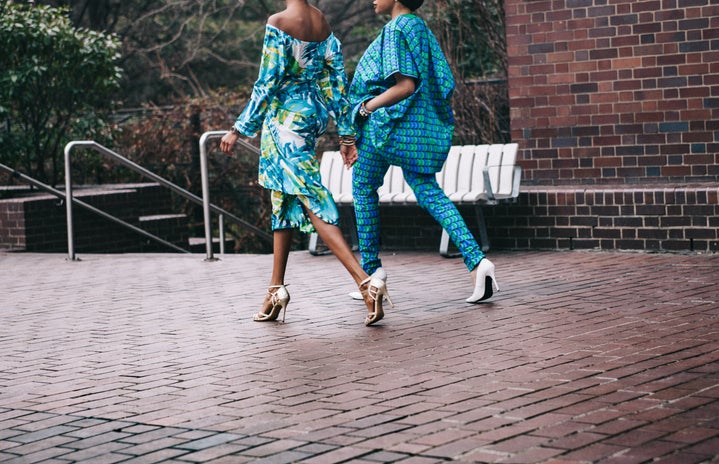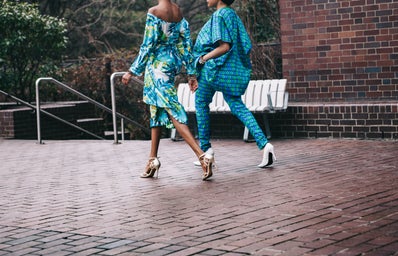Aneesa Mustafa, 23, embracing her pocket dress. Photo courtesy of Mustafa’s Instagram account @aneesamustafa.
“Sometimes when I see something with a pocket, I’ll buy it even if it’s ugly,” said Aneesa Mustafa, a 23-year-old feminist who believes her self-expression is hindered because women’s fashion lacks functionality.
“Buying a fashion item that has an element of usefulness [i.e pockets] is a feminist statement,” she said. “I deserve to look nice and…make further use of [clothes].”
Mustafa has “always been into fashion” and started curating her own look at the end of high school. With inspiration from her Instagram feed heaping with women’s fashion accounts, she’s constantly on the lookout for items that have both function and style.
Charles Cameron, 24, and Darleen Davis, 35, are co-owners of Filthy Rebena Vintage in downtown London and have been running their clothing store for over four years. They agreed that, although there are pockets in some women’s garments in their store, like pants, they’re usually “fake” or “incredibly shallow” and “unusable.”
Cameron also confirmed that more men’s clothing had pockets than women’s in their store.
“Definitely things [for women] will sell better if they have pockets. I would also say they are priced slightly higher,” said Davis. The owners further explained that clothing with pockets are a “big selling point” when customers are trying clothes on. “They often say ‘and it has pockets!’ at the fitting rooms,” Davis said.
Kelly Olson is an associate professor at Western University and teaches the course “Gender and Fashion” in the Women’s Studies department. She presented the argument that clothing has been designed to make women look smaller and that adding pockets can bulk the “ideal” silhouette. The author of two books on fashion antiquity explained that women didn’t historically need pockets because they didn’t have anything of economic value to place in them.
Olson also explained that women’s clothes didn’t have internal pockets until the 18th century. The earliest form of pockets were pouches tied around the waist underneath the petticoat of dresses and were difficult to access in public since they were underneath so much clothing. It wasn’t until later in the 1700s, when the pouches became a fashion accessory, that slits were made in the dress to allow easier access.
In the early 19th century, clothing became really slim, leaving no room for pockets. That’s when women started carrying “extremely tiny” purses known as ridicules, she said.
“[Now], the fashion industry thinks there is no need to makes pockets because [women] carry purses,” said Olson.
She also thinks that the creation of pockets in women’s garments could lead to a loss of profit in the purse industry.
“A lot of the times [customers] say their dress pants don’t have pockets so they will be carrying a purse or a clutch. Same thing with dresses. If you’re going out somewhere nice, you don’t have pockets,” said Morgan Duke, a sales associate at Bentley who’s been selling bags for three years.
Mustafa believes that “If you ever see an issue that is not being solved, it’s because there is money behind it. Women have become a part of the system to profit off of [because] you can’t just have one bag, you need multiples ones because of changing fashion.” She considers purses an example of a “pink tax,” the price added to everyday objects and services that are sold specifically to a female audience.
She also spoke about her phone being stolen at a mall because her jacket’s shallow pockets allowed the gadget to be half-seen. “It was so stressful and so painful and so frustrating because I have an ongoing issue with women’s clothing and I was even angrier at the patriarch,” she said.
When asked whether it was easier to pick-pocket women because their smaller pockets allowed easier access to items already partly out, Constable Sandasha Bough of the London Police said she was “unable to provide opinions on why people do or do not commit certain crimes” and “only the perpetrators would be able to answer that question.”
Ever since Mustafa got her phone stolen, she says she started shopping in the men’s section. She remembers being “embarrassed and awkward” at stores like Zara because she has “to shove [her] way through guys just to overcome [her] pocketlessness.”
Mustafa acknowledges that fashion is also getting slimmer for men. She recalls her dad complaining that his suit was “not looking good” because putting things in his now smaller pockets left “weird” outlines. “That’s how it’s been for women since forever. It’s a fad for men but its historical oppression for women,” Mustafa said.
In fashion, she says, “There are two worlds—fast and ethical, that battle.” She describes fast fashion as celebrity trends that last for a season and are easily replaceable without much functionality. Ethical fashion for Mustafa is Japanese brands like Uniqlo that are “comfy, useful and timeless with pockets.”
“[Ethical fashion is] really expensive but I’m willing to pay more not only because it’s beautiful but because it has pockets,” she said.
Going forwards, Mustafa does believe ethical fashion designers will start listening to consumers more since they are paying extra for things to invest in.
“I think pockets [are a] political statement regardless if one does or does not know their history. How many women go absolutely bonkers with excitement when an item of clothing has pockets they can actually use? Most of us! Do we all know the history and significance of pockets? Probably not, but what we do know is that we’ve been deprived of them and want more!”
Related Articles
- “On Trend” Fall Fashion Picks
- Goodwill Industries: Fashion Meets Benevolence
- How to Transition your Wardrobe for Fall?
Want more HCW? Check us out on social media!


